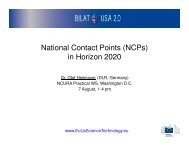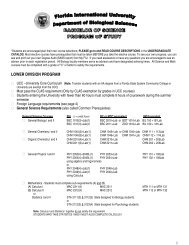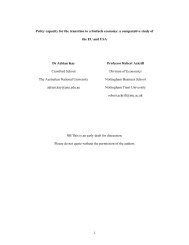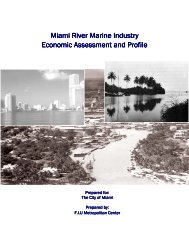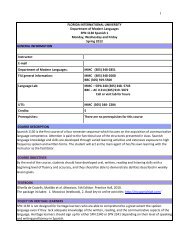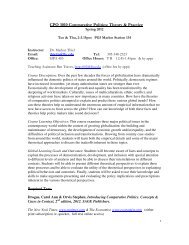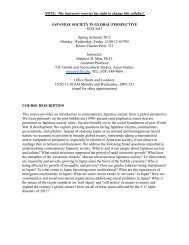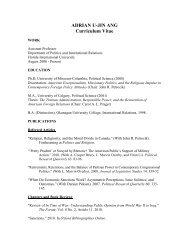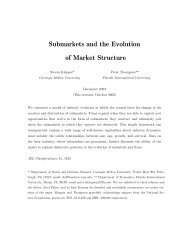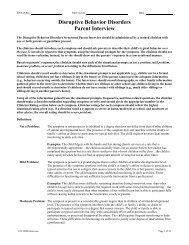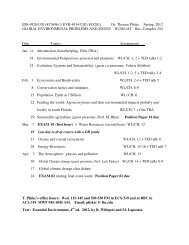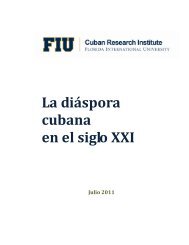Second Annual IFRI Forensic Science Symposium - College of Arts ...
Second Annual IFRI Forensic Science Symposium - College of Arts ...
Second Annual IFRI Forensic Science Symposium - College of Arts ...
Create successful ePaper yourself
Turn your PDF publications into a flip-book with our unique Google optimized e-Paper software.
<strong>Second</strong> <strong>Annual</strong> <strong>IFRI</strong> <strong>Forensic</strong> <strong>Science</strong> <strong>Symposium</strong> • March 13 - 14, 2013<br />
PLENARY SESSION – WEDNESDAY 2 P.M.<br />
1. Toolmark Examinations in the Lindbergh Kidnapping Case<br />
John M. Mancini, Miami-Dade Police Department: Crime Laboratory<br />
Oral Presentation Abstracts<br />
The Lindbergh kidnapping was one <strong>of</strong> the most high pr<strong>of</strong>ile and publicized investigations <strong>of</strong> its time. This presentation discusses the facts about the<br />
toolmark examinations performed during this case and the unorthodox evidence used. The examination led to some interesting breakthroughs in the<br />
investigation and helped to solve the case.<br />
2. Go With The Flow: Palm Beach County Sheriff’s Office Early User Evaluation Of The Rapidhit 200<br />
Karin Crenshaw, Palm Beach County Sheriff’s Office<br />
The Palm Beach County Sheriff’s Office has been involved in the application <strong>of</strong> micr<strong>of</strong>luidic devices for rapid DNA analysis since 2006. Advances<br />
in rapid DNA technology have included the introduction <strong>of</strong> the Rapid HIT 200 Human Identification System from IntegenX. The Rapid HIT 200<br />
instrument is a fully automated sample-to-answer system for STR-based human identification. A Rapid HIT 200 instrument was released to the<br />
Palm Beach County Sheriff’s Office <strong>Forensic</strong> Biology Unit in December 2012 for early user evaluation studies. <strong>Forensic</strong> laboratory involvement in the<br />
evaluation <strong>of</strong> a new product is a crucial step in establishing a working relationship between the forensic community and the manufacturer, ensuring<br />
the credibility <strong>of</strong> a particular instrument and maintaining the integrity <strong>of</strong> DNA analysis. The results, to date, demonstrate the instrument’s compatibility<br />
with existing commercially available chemistries to generate STR pr<strong>of</strong>iles in less than 90 minutes.<br />
3. Research Study for the Reliability <strong>of</strong> the ACE-V Process; Accuracy, Precision, Reproducibility and Repeatability<br />
in Latent Fingerprint Examinations<br />
Igor Pacheco and Brian Cerchiai, Miami-Dade Police Department<br />
Over 100 latent print examiners (LPE) from various local, state and federal law enforcement agencies participated in a research study to evaluate and<br />
compare unknown latent impressions to known standards. Eighty (80) unknown latent impressions and ten (10) known fingerprint and palm print<br />
standards were evaluated in three (3) phases over a ten (10) month period. Each latent impression was assigned a difficulty rating based on several<br />
metrics, including quality and quantity <strong>of</strong> minutiae. Over 5,900 suitability for identification determinations were reported. Participants were presented over<br />
6,100 ACE and 1,500 ACE-V trials and conducted a search <strong>of</strong> multiple fingerprint and palm print standards. Findings will be presented on the sufficiency<br />
for “<strong>of</strong> value” and “no value” determinations and accuracy <strong>of</strong> results. This study was funded by the National Institute <strong>of</strong> Justice (NIJ) under their program<br />
for understanding the accuracy, reliability, and measurement validity <strong>of</strong> forensic science disciplines. (Award # 2010-DN-BX-K268)<br />
4. Application <strong>of</strong> LA-ICP-MS for the elemental pr<strong>of</strong>iling <strong>of</strong> glass, ink, paper and chemical taggants.<br />
Tatiana Trejos and José R. Almirall, International <strong>Forensic</strong> Research Institute<br />
Laser Ablation Inductively Coupled Plasma Mass Spectrometry (LA-ICP-MS) is a micro-sampling leading technology that has been adopted by forensic<br />
laboratories worldwide for the elemental analysis and comparison <strong>of</strong> glass. The International <strong>Forensic</strong> Research Institute at FIU has been a leader in<br />
the validation <strong>of</strong> LA-ICP-MS for glass analysis and in the development <strong>of</strong> standard methods for the forensic examination <strong>of</strong> glass. This study presents<br />
results for interlaboratory studies conducted to validate the methodology and evaluate error rates. Our research group has extended the application<br />
<strong>of</strong> laser ablation methods to other matrices <strong>of</strong> forensic interest such as ink, paper and chemical taggants. This study presents a critical evaluation <strong>of</strong><br />
the performance <strong>of</strong> LA-ICP-MS for these matrices, including the analytical performance <strong>of</strong> the technique, discrimination potential, homogeneity <strong>of</strong> the<br />
samples at the micro-scale, reproducibility, sampling strategies, availability <strong>of</strong> matrix match standards, statistical analysis and interpretation <strong>of</strong> results. In<br />
addition, the utility <strong>of</strong> this technique in forensic science is demonstrated by presenting real casework examples.<br />
5. Advanced Genome Technology and <strong>Forensic</strong>s, Looking Forward Through the Lens <strong>of</strong> 25 Years <strong>of</strong> Casework (Keynote)<br />
Kevin C. McElfresh, Genome Identification Group<br />
The very first forensic DNA cases were done in 1987, twenty six years ago. STRs have been in use for the last 18 years. During this period, the human<br />
genome has been sequenced and advances in technology and science have delivered clear successors to STRs, specifically; Ultra-High Density SNP<br />
arrays, Next, Third and Fourth Generation whole genome sequencing, and all <strong>of</strong> these technologies have a clear application to forensics. STRs by<br />
most scientific standards are an antiquated technology yet they continue to provide sound results day in and day out in forensic laboratories around<br />
the world. The last 25 years <strong>of</strong> casework operations provides deep insight as to how best to consider the adoption <strong>of</strong> new technology. The challenge<br />
before us is to carefully weave the capabilities <strong>of</strong> the forensic laboratory, advanced technology, and the rigors <strong>of</strong> law enforcement into a coherent<br />
whole, that serves the lives <strong>of</strong> the people who have been victimized in the production <strong>of</strong> the samples that we analyze every day.<br />
Hosted by Florida International University | 11



